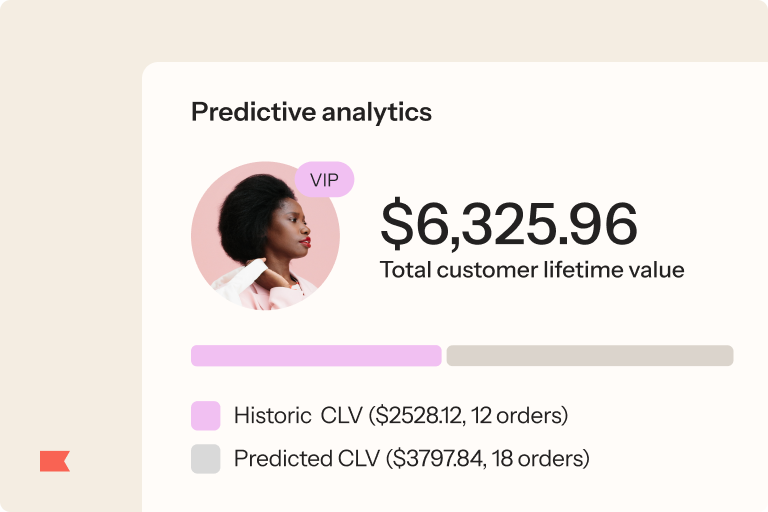Must-see apparel & accessories trends from the 2024 state of ecommerce report

In fashion, price and quality matter more than anything else.
That’s according to Klaviyo’s new 2024 state of ecommerce report, which reveals that price and quality are by far the most important factors influencing purchase decisions for 79% of apparel & accessories consumers.
And considering 56% of apparel & accessories brands have raised their prices this year, it’s clear that businesses in this space need to tread carefully in terms of attracting and retaining customers.
In such a dynamic market, being aware of broader trends and key statistics is not just beneficial—it’s essential for staying in style in the eyes of your customers.
The full report provides comprehensive insights into the state of ecommerce at large. Here, we offer a sneak peek into some of the most critical and relevant findings for apparel & accessories brands.
Insight 1: Apparel & accessories consumers only buy a few times a year
According to our report, 51% of survey respondents purchase apparel & accessories a few times a year, while 36% purchase once a month. Compared to industries like food & beverage or health & beauty, this is a relatively infrequent purchasing cadence.
Paired with the fact that consumers are price sensitive—and that 20% are planning to decrease their spending on apparel & accessories this year—it looks like brands in ecommerce fashion have their work cut out for them in terms of hitting their revenue goals.
No surprise, then, that many businesses indicated in our report that driving repeat purchases with existing customers is a top marketing priority for them this year.
In other words, now may be a great time to rethink your retention and CRM strategy.
How to use this insight to thrive in the apparel & accessories industry
In a crowded and competitive market, customer retention requires communicating with your customers in a way that makes them feel seen and special, rather than like just another transaction.
One way to do that: investing in more personalized marketing.
Sleepwear brand Little Sleepies adopted this approach during Black Friday Cyber Monday 2022 to get the most out of the biggest shopping season of the year.
Rather than bombarding everyone on their email list with daily emails, they used Klaviyo to target specific segments—like people who had engaged with the BFCM campaign the day before or visited their site in the last 24 hours—with personalized messaging.
As a result, Little Sleepies drove 138.2% YoY growth in email-attributed revenue.
Insight 2: Apparel & accessories brands might be underusing search, broadcast, and event marketing
Unlike in other industry verticals, where brands are frequently over-investing in marketing channels compared to those channels’ influence on consumers, marketers in the apparel & accessories space seem to have a strong understanding of where their target audiences prefer to engage with brands.
Notably, this is one of the only categories where the frequency of influencer marketing among marketers (31%) is well matched to the number of consumers who say influencer marketing affects their purchase decisions (32%).
Even more than influencer marketing, apparel & accessories brands are using email marketing most frequently (35%)—and 59% of consumers acknowledge email marketing as influential.
But there’s still room for improvement.
Consumers rank paid and organic search (79%) as even more influential than both email and influencer marketing—yet only 21% of apparel & accessories brands are tapping into this channel.
Broadcast advertising (58%) and event marketing (57%), meanwhile, are similarly important to consumers, but less than a third of apparel & accessories marketers use either—revealing opportunities for brands interested in developing creative ways to engage their existing customers and attract new ones.
How to use this insight to thrive in the apparel & accessories industry
Given that email marketing is both a focus for apparel & accessories companies and appealing to consumers, marketers should look for ways to enhance their email marketing strategies to maximize their effectiveness and return on investment.
One way to get the most out of email marketing is to pay attention to whether the messages you’re sending are actually landing with your customers, and invest in efforts and tactics for optimizing your email marketing performance.
Cargo Crew, a modern workwear apparel brand, uses Klaviyo A/B testing to optimize and improve their post-purchase flow. By testing various factors—from send times to subject lines—and seeing which ones perform the best, the brand grew revenue per recipient for their post-purchase flow by 3.5x.
Insight 3: Apparel & accessories brands are missing the mark when it comes to consumer preferences
Our report uncovered another significant gap: while apparel & accessories companies are making efforts to meet consumer needs, those efforts are not fully aligning with shoppers’ preferences.
Our survey of apparel & accessories consumers revealed that 93% want to take advantage of discounts and sales in this industry. Additionally, 87% use loyalty programs, and 80% value access to product reviews.
But rather than aligning with these preferences, we found that apparel & accessories companies may be over-investing in tactics that aren’t a top priority for consumers, such as user-generated content, buy-now-pay-later options, and livestream shopping.
This misalignment represents a substantial opportunity for businesses. By bridging this gap and better meeting consumer preferences, apparel & accessories companies have the potential to unlock significant additional revenue.
How to use this insight to thrive in the apparel & accessories industry
Even if you already offer discounts, have a loyalty program, and surface product reviews, there are always opportunities for optimization. Let’s take discounts, for instance. Rather than sending an email to all your subscribers about every single sale, you can take a more targeted approach to maximize your efficiency.
DKNY, a New York fashion brand, has a massive email list. But they weren’t getting the engagement they expected because they were sending general, frequent email campaigns and oversaturating their list with messages.
So they decided to cut down on volume by sending more personalized messages. The apparel brand now uses Klaviyo to target specific subscribers who are the most likely to take advantage of a discount. When they have a sale on bags for under $100, for example, they send an email specifically to a deal-hunters segment that, based on their average order value history, never spends much more than that amount.
Thanks to tactics like these, 30% of DKNY’s Klaviyo-attributed value now comes from flows.
Insight 4: Fashionistas want to shop both online and IRL
It’s no surprise that 74% of apparel & accessories companies make revenue from transactions that take place on their own ecommerce websites.
What might be more surprising is that third-party ecommerce sites and marketplace transactions, as well as transactions at owned and operated physical retail stores, are close behind, at 66%.
But while 52% of consumers purchase clothes, shoes, and bags from brands’ own ecommerce websites, they’re even more likely to purchase from third-party ecommerce sites like Amazon (53%) and brands’ own physical retail stores (66%).
Given how evenly these customer preferences are split, there’s an opportunity to help customers understand the full range of shopping experiences available to them.
How to use this insight to thrive in the apparel & accessories industry
Marine Layer is an apparel brand that has two sales channels: brick-and-mortar stores and ecommerce. Even though their operations behind the scenes looked quite different for those two channels, they need to present to their customers as one seamless brand.
To do this, Marine Layer finds creative ways to help customers understand the various shopping options they can take advantage of—like launching two custom welcome flows: one for people who subscribe online, and one for people who do it IRL.
The welcome flow for in-person shoppers highlights the extensive online selection, and Marine Layer’s free shipping and returns policy. The welcome flow for DTC shoppers is more focused on boosting awareness of Marine Layer’s retail stores and encouraging repeat online purchases.
Tactics like these have contributed to 40.4% YoY growth in Klaviyo-attributed revenue for the brand.
Tailor your marketing strategy for the perfect fit
It’s clear from the high-level findings of our report that apparel & accessories companies need to focus on driving repeat purchases with existing customers this year.
But to do so, they may need to reevaluate their marketing mix and make sure it aligns with their customers’ preferences.
By understanding the broader trends in the apparel & accessories industry, you can guide your marketing strategy in the right direction—rather than relying on untested assumptions that can lead to a misallocation of valuable resources.
<CTA> Want to dive deeper into the state of the ecommerce industry? Get the report
Related content
- Boost your CPG ecommerce strategy with these 2024 food & beverage insights
- Home & garden marketing best practices: key insights from the 2024 state of ecommerce report
- Key health & beauty industry insights from the 2024 state of ecommerce report

Related content

See how Customer Hub, Customer Agent, and Helpdesk powered faster support, reduced tickets, and boosted revenue during Klaviyo Service’s first BFCM.

Post-purchase experiences are where customer loyalty begins. Learn how to automate and personalize them to grow your B2C brand

Discover how lifecycle marketing transforms your CRM into a growth engine, driving retention, automation, and personalized B2C customer experiences.